Geoadditive Quantile Regression Model for Sewer Pipes Deterioration Using Boosting Optimization Algorithm
Abstract
1. Introduction
2. Mathematical Formulation
- First, collection of the available data including inspection data (e.g., observed defects, their severity, their orientation and their location), pipe characteristics (e.g., length, diameter, material type, buried depth and slope) and maintenance data (e.g., number of previous flushes, number of previous reported backups). If available, the operational data (e.g., dry weather flow, wet weather flow, inflow infiltration) are also collected.
- Second, data processing where variables are classified into categorical (e.g., material) and continuous (e.g., diameter). The response variable is the internal condition of the pipe that is expressed in terms of score obtained after rating the observed defects following a grading protocol (e.g., Water Resource Center: WRc). The model equation is developed, and the base learners’ priors are selected.
- Third, the last step is simulation and model performance evaluation. The number of iterations and step-length are set to the same values in both quantiles. The validated models are used for predictions and the effect of the selected covariates are examined.
2.1. Geoadditive Quantile Regression
2.2. Boosting Algorithm
| Algorithm 1: Component-wise functional gradient descent boosting algorithm for structured additive quantile regression. | |
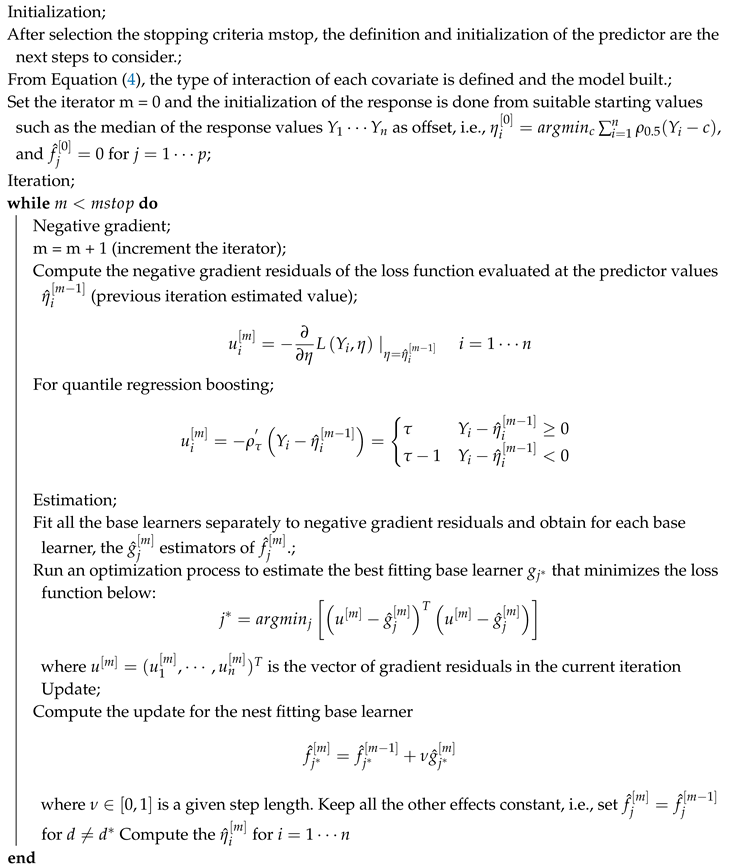 | |
3. Case Study
3.1. Inspection Data Collection and Processing
3.2. Factors Selection and Model Development
3.3. Response Variable
4. Results and Discussion
4.1. Model Selected Covariates
4.2. Covariates’ Effects on the Response Variable
4.3. Spatial Effects
4.4. Discussion
5. Conclusions
6. Future Research Needs
Author Contributions
Funding
Acknowledgments
Conflicts of Interest
Abbreviations
| SQRM | Structured Quantile Regression model |
| GMRF | Gaussian Markov Random Filed |
| ICG | Internal Condition Grading |
| EPA | Environmental Protection Agency |
| AC | Asbestos Cement |
| CON | Concrete |
| BR | Brick |
| VCT | Vitrified clay |
| ST | Steel |
| CI | Cast iron |
| CMP | Corrugated metal pipes |
| PVC | Polyvinyl chloride |
| PE | Polyethylene |
References
- US-EPA. Rehabilitation of Wastewater Collection and Water Distribution Systems, State of the Technology Review Report; US Environmental Protection Agency: Edison, NJ, USA, 2009.
- Vahidi, E.; Jin, E.; Das, M.; Singh, M.; Zhao, F. Environmental life cycle analysis of pipe materials for sewer systems. Sustain. Cities Soc. 2016, 27, 167–174. [Google Scholar] [CrossRef]
- Fenner, R.A. Approaches to sewer maintenance: A review. Urban Water 2000, 2, 343–356. [Google Scholar] [CrossRef]
- Korving, H.; Van Noortwijk, J.M.; Van Gelder, P.H.; Clemens, F.H. Risk-based design of sewer system rehabilitation. Struct. Infrastruct. Eng. 2009, 5, 215–227. [Google Scholar] [CrossRef]
- Mancuso, A.; Compare, M.; Salo, A.; Zio, E.; Laakso, T. Risk-based optimization of pipe inspections in large underground networks with imprecise information. Reliab. Eng. Syst. Saf. 2016, 152, 228–238. [Google Scholar] [CrossRef]
- Syachrani, S.; Jeong, H.S.; Chung, C.S. Dynamic deterioration models for sewer pipe network. J. Pipeline Syst. Eng. Pract. 2011, 2, 123–131. [Google Scholar] [CrossRef]
- Infrastructure Canada. Canadian Infrastructure Report Card-Informing the Future. 2016. Available online: http://canadianinfrastructure.ca/en/index.html (accessed on 20 October 2020).
- Malek Mohammadi, M.; Najafi, M.; Kaushal, V.; Serajiantehrani, R.; Salehabadi, N.; Ashoori, T. Sewer Pipes Condition Prediction Models: A State-of-the-Art Review. Infrastructures 2019, 4, 64. [Google Scholar] [CrossRef]
- Balekelayi, N.; Tesfamariam, S. Statistical inference of sewer pipe deterioration using Bayesian geoadditive regression model. J. Infrastruct. Syst. 2019, 25, 04019021. [Google Scholar] [CrossRef]
- Fenske, N.; Kneib, T.; Hothorn, T. Identifying risk factors for severe childhood malnutrition by boosting additive quantile regression. J. Am. Stat. Assoc. 2011, 106, 494–510. [Google Scholar] [CrossRef]
- Ana, E.; Bauwens, W. Modeling the structural deterioration of urban drainage pipes: The state-of-the-art in statistical methods. Urban Water J. 2010, 7, 47–59. [Google Scholar] [CrossRef]
- Rajani, B.; Tesfamariam, S. Uncoupled axial, flexural, and circumferential pipe soil interaction analyses of partially supported jointed water mains. Can. Geotech. J. 2004, 41, 997–1010. [Google Scholar] [CrossRef]
- Kleiner, Y.; Rajani, B. Comprehensive review of structural deterioration of water mains: Statistical models. Urban Water 2001, 3, 131–150. [Google Scholar] [CrossRef]
- Mashford, J.; Marlow, D.; Tran, D.; May, R. Prediction of sewer condition grade using support vector machines. J. Comput. Civ. Eng. 2010, 25, 283–290. [Google Scholar] [CrossRef]
- Kabir, E.; Guikema, S.; Kane, B. Statistical modeling of tree failures during storms. Reliab. Eng. Syst. Saf. 2018, 177, 68–79. [Google Scholar] [CrossRef]
- Balekelayi, N. Advanced Deterioration Models for Wastewater Inspection Prioritization. Ph.D. Thesis, University of British Columbia, Vancouver, BC, Canada, 2019. [Google Scholar]
- Duchesne, S.; Beardsell, G.; Villeneuve, J.P.; Toumbou, B.; Bouchard, K. A survival analysis model for sewer pipe structural deterioration. Comput. Aided Civ. Infrastruct. Eng. 2013, 28, 146–160. [Google Scholar] [CrossRef]
- Baah, K.; Dubey, B.; Harvey, R.; McBean, E. A risk-based approach to sanitary sewer pipe asset management. Sci. Total Environ. 2015, 505, 1011–1017. [Google Scholar] [CrossRef]
- Gedam, A.; Mangulkar, S.; Gandhi, B. Prediction of sewer pipe main condition using the linear regression approach. J. Geosci. Environ. Prot. 2016, 4, 100–105. [Google Scholar] [CrossRef]
- Coppi, R. Management of uncertainty in statistical reasoning: The case of regression analysis. Int. J. Approx. Reason. 2008, 47, 284–305. [Google Scholar] [CrossRef]
- Su, Z.G.; Wang, Y.F.; Wang, P.H. Parametric regression analysis of imprecise and uncertain data in the fuzzy belief function framework. Int. J. Approx. Reason. 2013, 54, 1217–1242. [Google Scholar] [CrossRef]
- Caradot, N.; Riechel, M.; Fesneau, M.; Hernandez, N.; Torres, A.; Sonnenberg, H.; Eckert, E.; Lengemann, N.; Waschnewski, J.; Rouault, P. Practical benchmarking of statistical and machine learning models for predicting the condition of sewer pipes in Berlin, Germany. J. Hydroinform. 2018, 20, 1131–1147. [Google Scholar] [CrossRef]
- Kaddoura, K.; Zayed, T. An integrated assessment approach to prevent risk of sewer exfiltration. Sustain. Cities Soc. 2018, 41, 576–586. [Google Scholar] [CrossRef]
- Salman, B. Infrastructure Management and Deterioration Risk Assessment of Wastewater Collection Systems. Ph.D. Thesis, University of Cincinnati, Cincinnati, OH, USA, 2010. [Google Scholar]
- Baik, H.S.; Jeong, H.S.; Abraham, D.M. Estimating transition probabilities in Markov chain-based deterioration models for management of wastewater systems. J. Water Resour. Plan. Manag. 2006, 132, 15–24. [Google Scholar] [CrossRef]
- Ariaratnam, S.T.; El-Assaly, A.; Yang, Y. Assessment of infrastructure inspection needs using logistic models. J. Infrastruct. Syst. 2001, 7, 160–165. [Google Scholar] [CrossRef]
- Wirahadikusumah, R.; Abraham, D.; Iseley, T. Challenging issues in modeling deterioration of combined sewers. J. Infrastruct. Syst. 2001, 7, 77–84. [Google Scholar] [CrossRef]
- Wang, C.; Zhang, H.; Li, Q. Reliability assessment of aging structures subjected to gradual and shock deteriorations. Reliab. Eng. Syst. Saf. 2017, 161, 78–86. [Google Scholar] [CrossRef]
- Dirksen, J.; Clemens, F.; Korving, H.; Cherqui, F.; Le Gauffre, P.; Ertl, T.; Plihal, H.; Müller, K.; Snaterse, C. The consistency of visual sewer inspection data. Struct. Infrastruct. Eng. 2013, 9, 214–228. [Google Scholar] [CrossRef]
- Davies, J.; Clarke, B.; Whiter, J.; Cunningham, R. Factors influencing the structural deterioration and collapse of rigid sewer pipes. Urban Water 2001, 3, 73–89. [Google Scholar] [CrossRef]
- Laakso, T.; Kokkonen, T.; Mellin, I.; Vahala, R. Sewer condition prediction and analysis of explanatory factors. Water 2018, 10, 1239. [Google Scholar] [CrossRef]
- Syachrani, S.; Jeong, H.S.D.; Chung, C.S. Decision tree–based deterioration model for buried wastewater pipelines. J. Perform. Constr. Facil. 2013, 27, 633–645. [Google Scholar] [CrossRef]
- Kneib, T.; Fahrmeir, L. A mixed model approach for geoadditive hazard regression. Scand. J. Stat. 2007, 34, 207–228. [Google Scholar] [CrossRef]
- Balekelayi, N.; Tesfamariam, S. Geoadditive Bayesian regression models for water mains failure rate prediction. In Proceedings of the 13th International Conference on Applications of Statistics and Probability in Civil Engineering, ICASP13, Seoul, Korea, 26–30 May 2019; Volume 1, pp. 1–8. [Google Scholar]
- Post, J.; Langeveld, J.; Clemens, F. Analysing spatial patterns in lateral house connection blockages to support management strategies. Struct. Infrastruct. Eng. 2017, 13, 1146–1156. [Google Scholar] [CrossRef]
- Fragoso, T.M.; Bertoli, W.; Louzada, F. Bayesian model averaging: A systematic review and conceptual classification. Int. Stat. Rev. 2018, 86, 1–28. [Google Scholar] [CrossRef]
- Hofner, B.; Mayr, A.; Robinzonov, N.; Schmid, M. Model-based boosting in R: A hands-on tutorial using the R package mboost. Comput. Stat. 2014, 29, 3–35. [Google Scholar] [CrossRef]
- Kabir, G.; Balekelayi, N.C.; Tesfamariam, S. Sewer structural condition prediction integrating Bayesian model averaging with logistic regression. J. Perform. Constr. Facil. 2018, 32, 04018019. [Google Scholar] [CrossRef]
- Malek Mohammadi, M.; Najafi, M.; Salehabadi, N.; Serajiantehrani, R.; Kaushal, V. Predicting Condition of Sanitary Sewer Pipes with Gradient Boosting Tree. In Pipelines 2020; American Society of Civil Engineers Reston: Reston, VA, USA, 2020; pp. 80–89. [Google Scholar]
- Yue, Y.R.; Rue, H. Bayesian inference for additive mixed quantile regression models. Comput. Stat. Data Anal. 2011, 55, 84–96. [Google Scholar] [CrossRef]
- Snider, B.; McBean, E.A. Improving time to failure predictions for water distribution systems using extreme gradient boosting algorithm. In Proceedings of the WDSA/CCWI Joint Conference, Kingston, ON, Canada, 23–25 July 2018; Volume 1. [Google Scholar]
- Balekelayi, N.; Tesfamariam, S. Advanced Water Main Deterioration Model Using Bayesian Geoadditive Quantile Regression. In Encyclopedia of Water: Science, Technology, and Society; John Wiley & Sons Ltd.: Hoboken, NJ, USA, 2019; pp. 1–14. Available online: https://onlinelibrary.wiley.com/doi/book/10.1002/9781119300762 (accessed on 19 October 2020).
- März, A.; Klein, N.; Kneib, T.; Musshoff, O. Analysing farmland rental rates using Bayesian geoadditive quantile regression. Eur. Rev. Agric. Econ. 2016, 43, 663–698. [Google Scholar] [CrossRef]
- Marlow, D.; Heart, S.; Burn, S.; Urquhart, A.; Gould, S.; Anderson, M.; Cook, S.; Ambrose, M.; Madin, B.; Fitzgerald, A. Condition Assessment Strategies and Protocols for Water and Wastewater Utility Assets; Project Ref. 03-CTS-20CO; Water Environment Research Foundation: Alexandria, VA, USA, 2007. [Google Scholar]
- Waldmann, E.; Kneib, T.; Yue, Y.R.; Lang, S.; Flexeder, C. Bayesian semiparametric additive quantile regression. Stat. Model. 2013, 13, 223–252. [Google Scholar] [CrossRef]
- Scheipl, F.; Kneib, T.; Fahrmeir, L. Penalized likelihood and Bayesian function selection in regression models. AStA Adv. Stat. Anal. 2013, 97, 349–385. [Google Scholar] [CrossRef]
- Sobotka, F.; Kneib, T. Geoadditive expectile regression. Comput. Stat. Data Anal. 2012, 56, 755–767. [Google Scholar] [CrossRef]
- Kneib, T.; Hothorn, T.; Tutz, G. Variable selection and model choice in geoadditive regression models. Biometrics 2009, 65, 626–634. [Google Scholar] [CrossRef]
- Rue, H.; Held, L. Gaussian Markov Random Fields: Theory and Applications; CRC Press: Boca Raton, FL, USA, 2005. [Google Scholar]
- Koenker, R.; Bassett, G., Jr. Regression quantiles. Econom. J. Econom. Soc. 1978, 46, 33–50. [Google Scholar] [CrossRef]
- Friedman, J.H. Greedy function approximation: A gradient boosting machine. Ann. Stat. 2001, 29, 1189–1232. [Google Scholar] [CrossRef]
- Winkler, D.; Haltmeier, M.; Kleidorfer, M.; Rauch, W.; Tscheikner-Gratl, F. Pipe failure modelling for water distribution networks using boosted decision trees. Struct. Infrastruct. Eng. 2018, 14, 1402–1411. [Google Scholar] [CrossRef]
- Bühlmann, P.; Hothorn, T. Boosting algorithms: Regularization, prediction and model fitting. Stat. Sci. 2007, 22, 477–505. [Google Scholar] [CrossRef]
- Baur, R.; Herz, R. Selective inspection planning with ageing forecast for sewer types. Water Sci. Technol. 2002, 46, 389–396. [Google Scholar] [CrossRef]
- Davies, J.; Clarke, B.; Whiter, J.; Cunningham, R.; Leidi, A. The structural condition of rigid sewer pipes: A statistical investigation. Urban Water 2001, 3, 277–286. [Google Scholar] [CrossRef]
- Langrock, R.; Kneib, T.; Sohn, A.; DeRuiter, S.L. Nonparametric inference in hidden Markov models using P-splines. Biometrics 2015, 71, 520–528. [Google Scholar] [CrossRef]
- Salman, B.; Salem, O. Risk assessment of wastewater collection lines using failure models and criticality ratings. J. Pipeline Syst. Eng. Pract. 2012, 3, 68–76. [Google Scholar] [CrossRef]
- Chughtai, F.; Zayed, T. Infrastructure condition prediction models for sustainable sewer pipelines. J. Perform. Constr. Facil. 2008, 22, 333–341. [Google Scholar] [CrossRef]
- Tran, D.; Ng, A.; Perera, B.; Burn, S.; Davis, P. Application of probabilistic neural networks in modelling structural deterioration of stormwater pipes. Urban Water J. 2006, 3, 175–184. [Google Scholar] [CrossRef]
- Micevski, T.; Kuczera, G.; Coombes, P. Markov model for storm water pipe deterioration. J. Infrastruct. Syst. 2002, 8, 49–56. [Google Scholar] [CrossRef]
- Younis, R.; Knight, M.A. A probability model for investigating the trend of structural deterioration of wastewater pipelines. Tunn. Undergr. Space Technol. 2010, 25, 670–680. [Google Scholar] [CrossRef]
- Ana, E.; Bauwens, W.; Pessemier, M.; Thoeye, C.; Smolders, S.; Boonen, I.; De Gueldre, G. An investigation of the factors influencing sewer structural deterioration. Urban Water J. 2009, 6, 303–312. [Google Scholar] [CrossRef]
- Røstum, J. Statistical Modelling of Pipe Failures in Water Networks. Ph.D. Thesis, Norwegian University of Science and Technology NTNU, Trondheim, Norway, 2000. [Google Scholar]
- Kley, G.; Caradot, N. Review of Sewer Deterioration Models; KWB Project SEMA, Report 1; Cicerostr: Berlin, Germany, 2013. [Google Scholar]

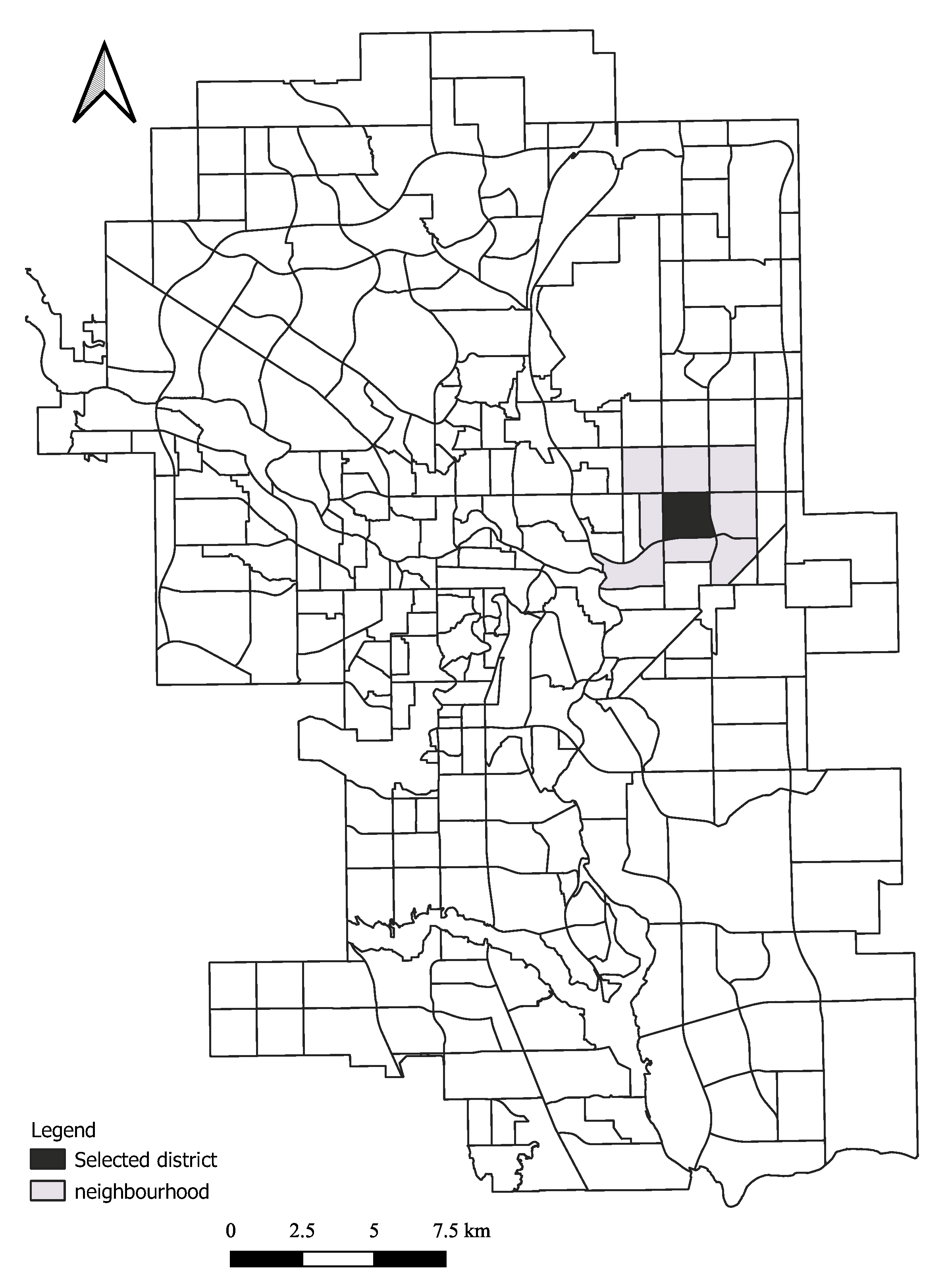
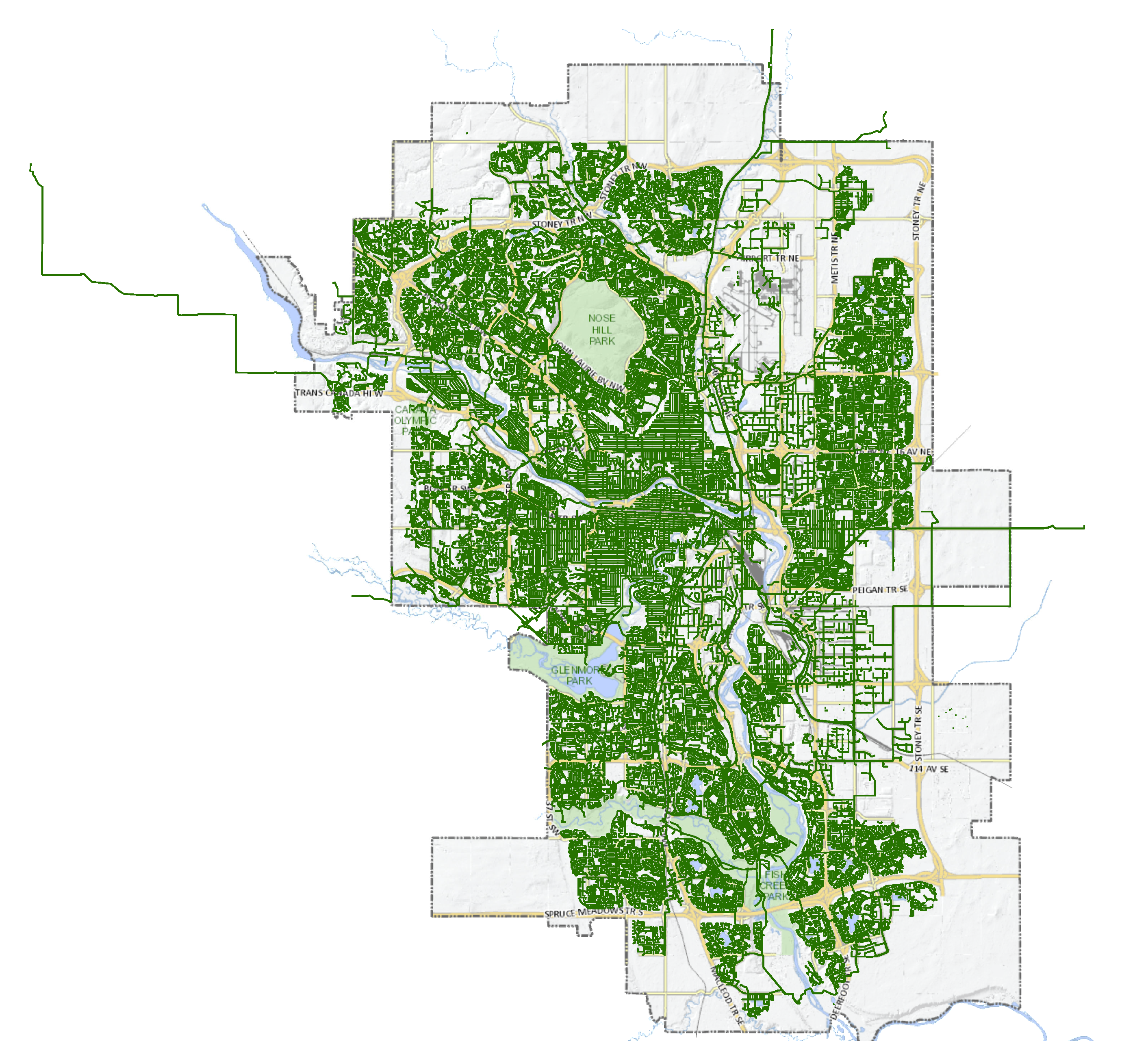

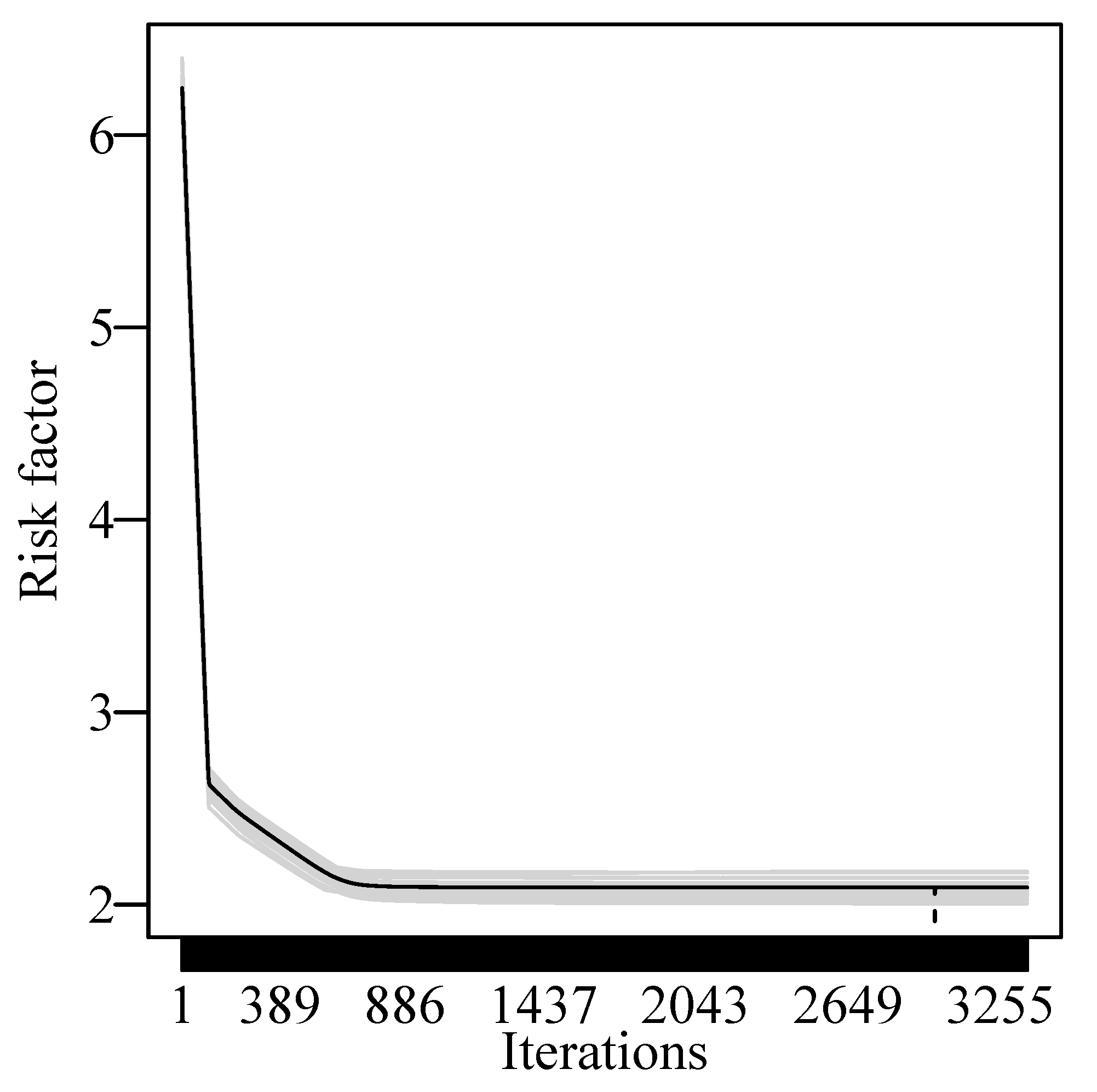
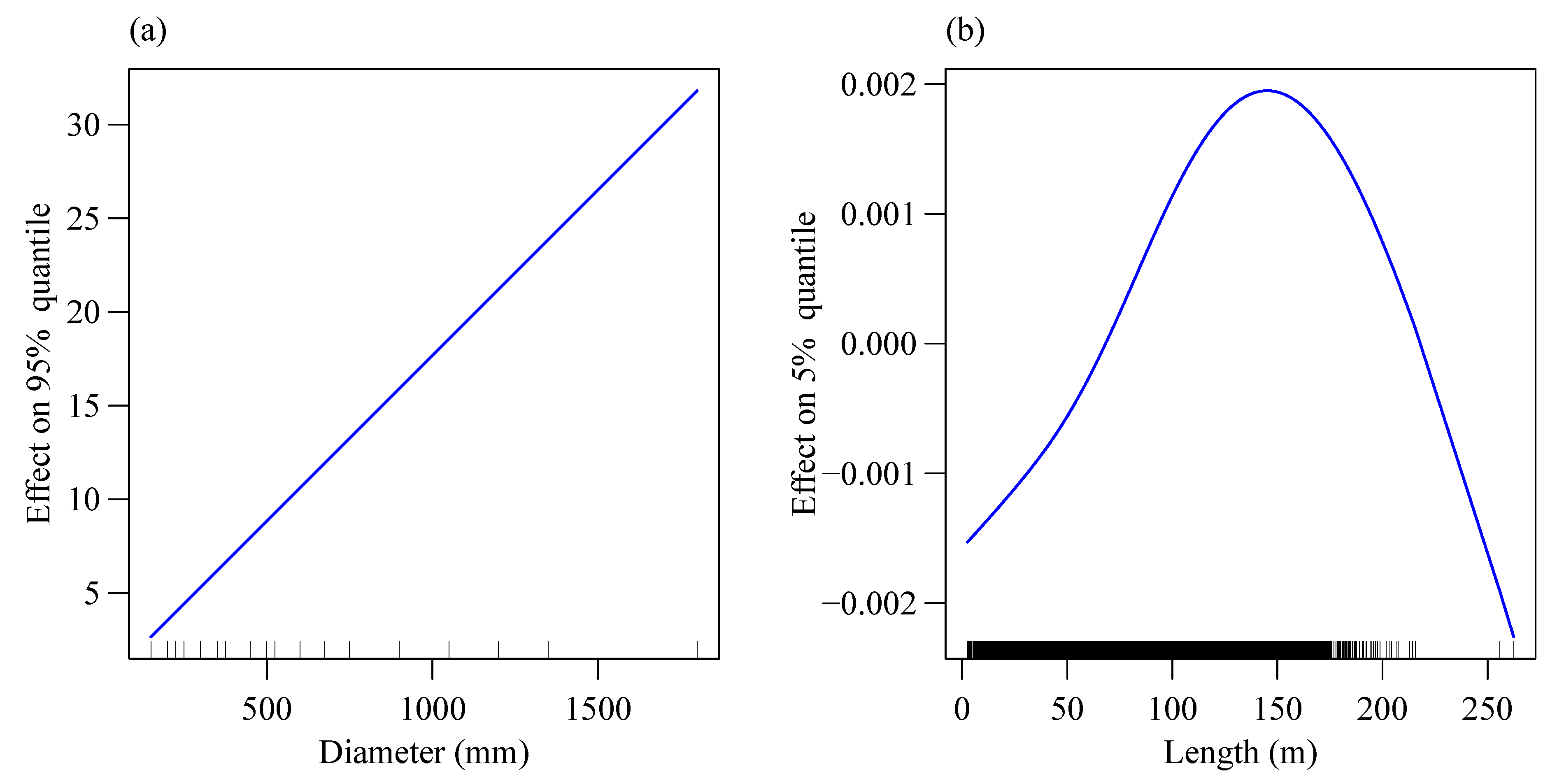


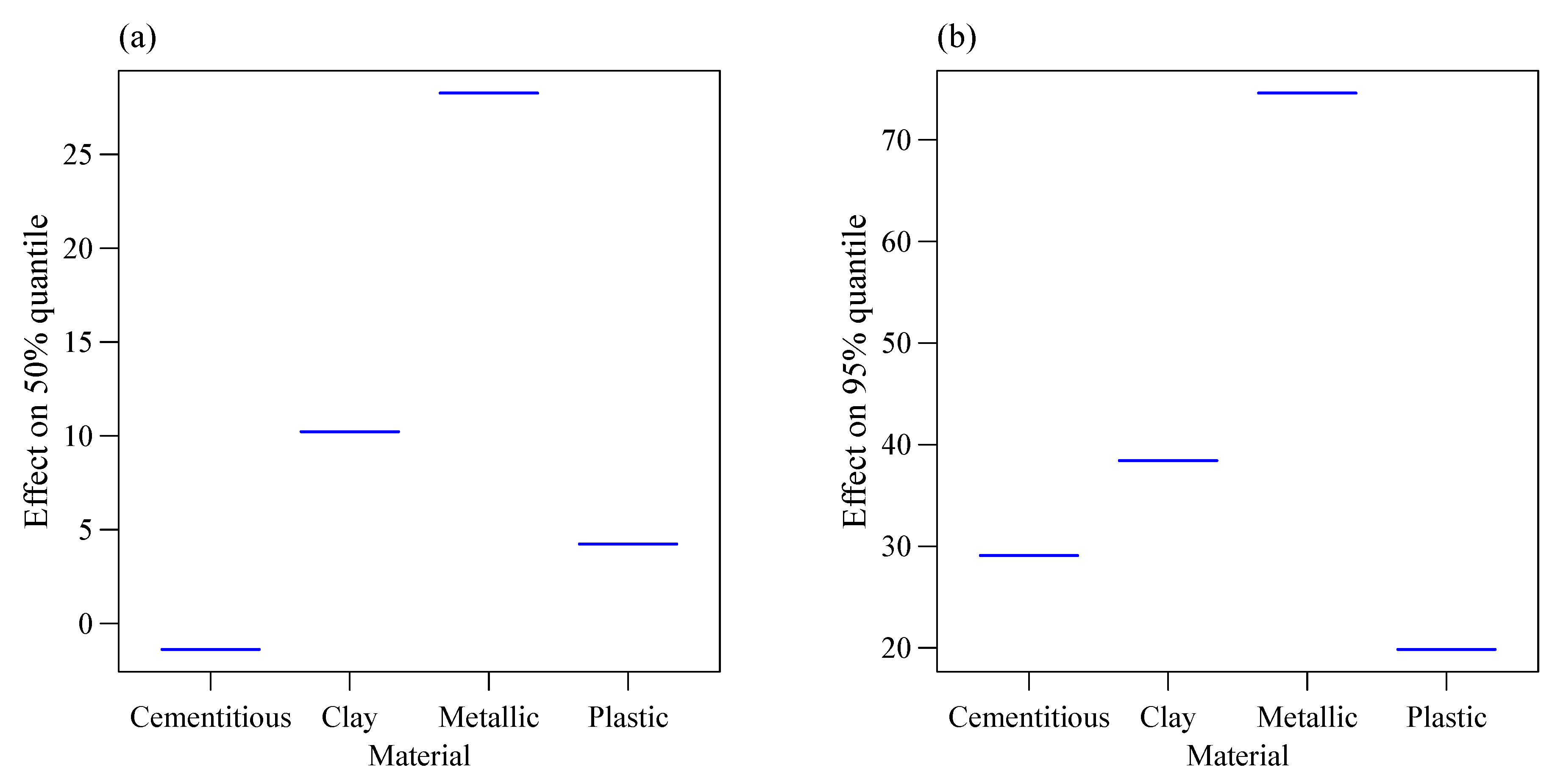
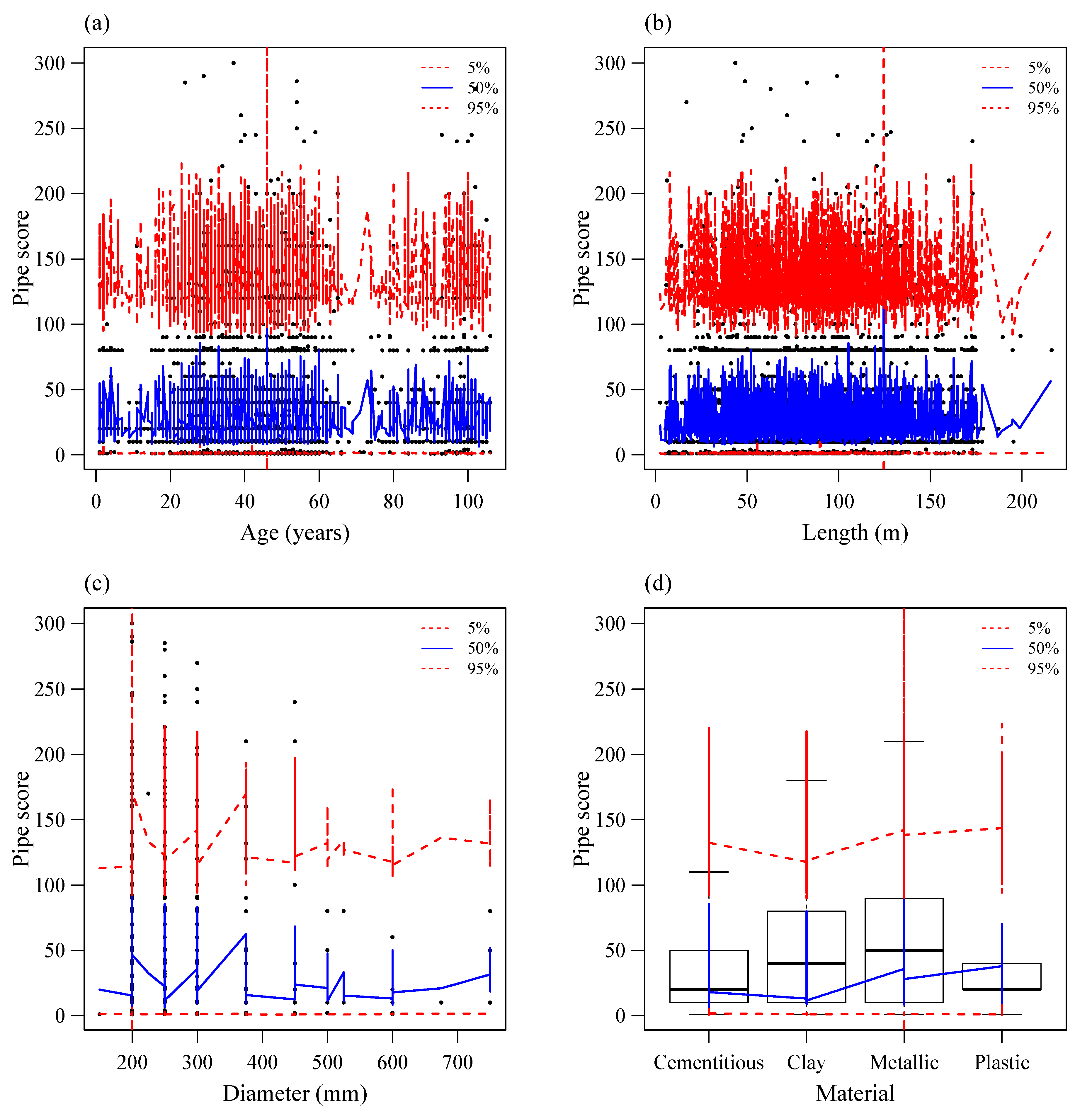

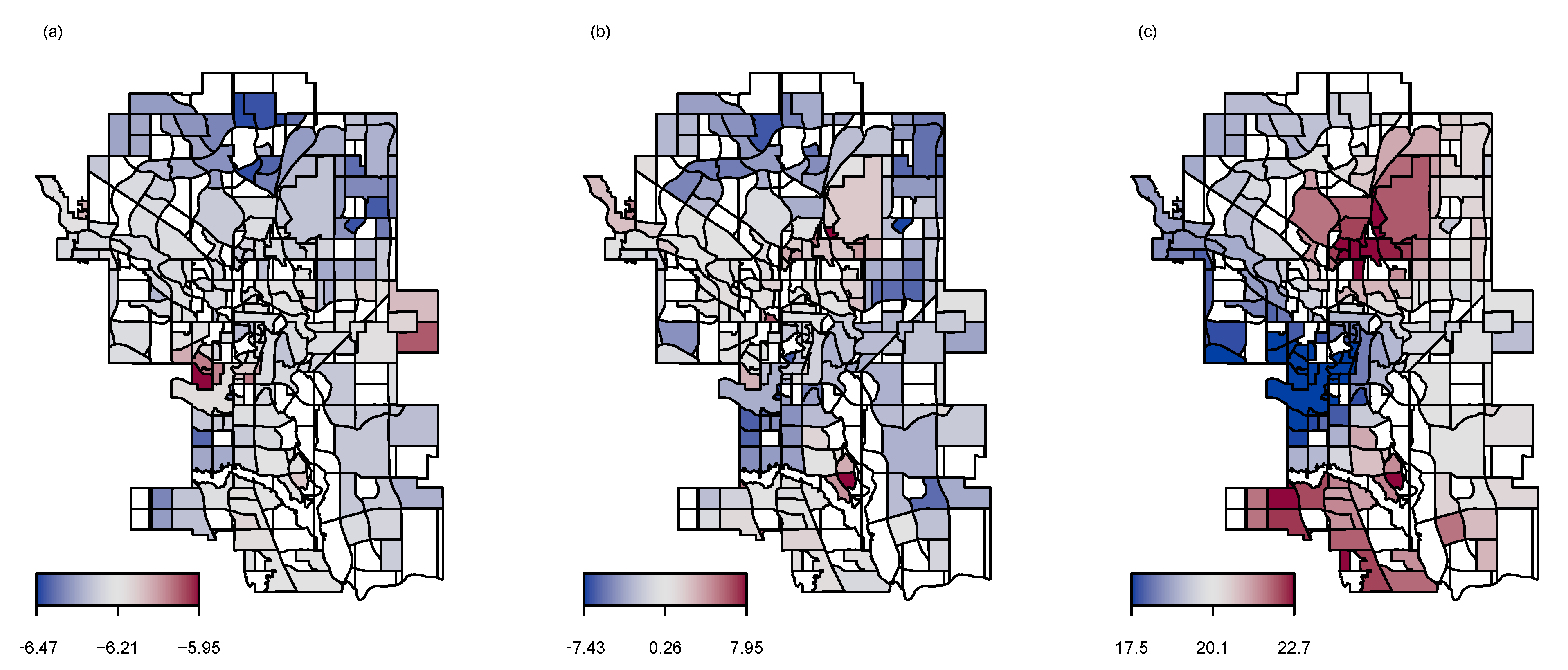
| Covariates (Physical) | Description |
|---|---|
| Material | Designed material of pipes (categorical: 1 = cementitious, 2 = clay, 3 = metallic, 4 = plastic) |
| Age | The difference between the inspection date and the installation date (continuous) |
| Length | The manhole to manhole distance inspected (continuous) |
| Diameter | size of the pipes (continuous) |
| Depth | mean distance from the crown of the pipe to the ground surface (continuous) |
| Slope | Angle between the pipes axis with the horizontal (continuous) |
| rservs | Number of residential connections to the pipe (continuous) |
| cservs | Number of commercial buildings connected to the pipe (continuous) |
| Covariates (Maintenance) | |
| Flushes | Number of flushes done previously on the sewer pipe (continuous) |
| repairs | Number of previous repairs on the sewer pipe (continuous) |
| Rcuts | Number of times, the roots have been cut from inside the pipe (continuous) |
| Backups | Number of times, there have been water backups in the sewers (continuous) |
| Degrease | Number of time, the maintenance team have degreased the sewer pipe (continuous) |
| Cleaning | Number of time, the sewer pipes have been cleaned (continuous) |
| Covariates (Environmental) | |
| Geospatial location | The geographic location of the sewer pipe. While it is widely accepted that pipes having the same characteristics deteriorates at the same pace, there is a variation in the deterioration across pipes in the same cohort but affected by different environmental covariates such as the nature of the soil they are buried in, the groundwater fluctuation, soil compaction, traffic on the ground, activities in the vicinity. These unobserved and unknown data have correlated and uncorrelated effects on the structural response |
| Covariates | 5th Percentile | 50th Percentile | 95th Percentile | |||
|---|---|---|---|---|---|---|
| Linear | Nonlinear | Linear | Nonlinear | Linear | Nonlinear | |
| Age | - | - | x | x | x | x |
| rservs | - | x | x | x | x | |
| cservs | - | x | x | - | x | - |
| Length | - | x | - | - | - | - |
| Diameter | - | - | - | - | x | - |
| Material | x | - | x | - | x | - |
| Flushes | - | x | x | x | - | x |
| Cleaning | - | x | - | x | - | - |
| Degrease | - | x | - | x | - | - |
| Backups | - | x | - | x | - | - |
| Roots | - | x | - | x | - | - |
| repairs | x | x | x | x | x | x |
| Replaced | - | - | X | - | x | - |
| Slope | - | x | - | x | - | - |
| Depth | - | x | - | x | - | - |
Publisher’s Note: MDPI stays neutral with regard to jurisdictional claims in published maps and institutional affiliations. |
© 2020 by the authors. Licensee MDPI, Basel, Switzerland. This article is an open access article distributed under the terms and conditions of the Creative Commons Attribution (CC BY) license (http://creativecommons.org/licenses/by/4.0/).
Share and Cite
Balekelayi, N.; Tesfamariam, S. Geoadditive Quantile Regression Model for Sewer Pipes Deterioration Using Boosting Optimization Algorithm. Sustainability 2020, 12, 8733. https://doi.org/10.3390/su12208733
Balekelayi N, Tesfamariam S. Geoadditive Quantile Regression Model for Sewer Pipes Deterioration Using Boosting Optimization Algorithm. Sustainability. 2020; 12(20):8733. https://doi.org/10.3390/su12208733
Chicago/Turabian StyleBalekelayi, Ngandu, and Solomon Tesfamariam. 2020. "Geoadditive Quantile Regression Model for Sewer Pipes Deterioration Using Boosting Optimization Algorithm" Sustainability 12, no. 20: 8733. https://doi.org/10.3390/su12208733
APA StyleBalekelayi, N., & Tesfamariam, S. (2020). Geoadditive Quantile Regression Model for Sewer Pipes Deterioration Using Boosting Optimization Algorithm. Sustainability, 12(20), 8733. https://doi.org/10.3390/su12208733




